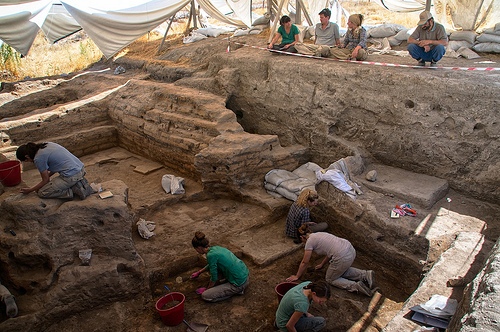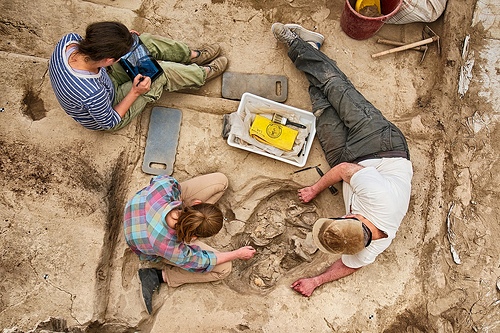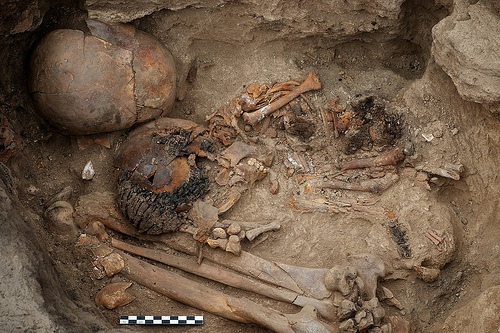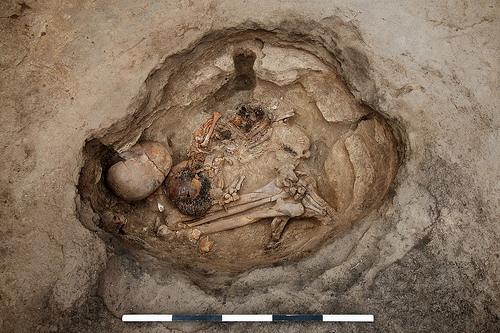
The Çatalhöyük Research Project, an effort that consists of an international team of archaeologists and other experts from a consortium of universities and research institutions, has announced upcoming conferences to showcase and discuss the latest thinking about the excavation results at the iconic Neolithic and Chalcolithic proto-city settlement in southern Anatolia, in present-day Turkey.
On location near the excavation site, the meetings will take place among two separate but adjoining conference sessions from August 2 through August 4, 2014. The first is part of a Templeton-funded project that is exploring the role of religion and ritual in the origin of settled life. Conference organizers are interested in addressing three foci related to this theme: The first concerning the repetitive building of houses or cult buildings in the same place; the second, the possible cosmological layout of settlements; and the third, the timing of the emergence of a concern with history-making in a place, and its cosmological layout. “At what point in regional sequences do such features emerge and with what does their appearance correlate?”, write the organizers. “Can such correlations be used to suggest the causal processes that produced such features; causal processes such as agricultural intensification, population increase, social competition and so on?” The second conference is part of a Polish National Science Center grant aimed at investigating the upper Late Neolithic strata of the East mound at Çatalhöyük and recognizing the demise of the previously vibrant mega-city. This conference aims to address three intertwined issues: The first concerns the character of changes in other parts of the Near East in the second half of the 7th millennium BCE in relation to the developments at Çatalhöyük in a broader regional context; the second issue comprises social and ideological changes taking place at the end of the Neolithic and the beginning of the Chalcolithic; and the third concerns the changes in lifeways, subsistence basis, environment exploitation, and the modes of procurement, consumption and distribution of different resources. “Did the Late Neolithic farmers,” added the organizers, “start to exploit a different set of resources originating from previously unexplored areas? Did the end of the 7th millennium BCE involve changes in farming strategies and shifts in the consumption patterns?”
Çatalhöyük has been considered by scholars as a key example of the development of the world’s earliest societies. Initially excavated by James Mellaart in the early 1960s, the site has been widely recognised as one of the first urban centers in the world (at 7400 BCE) and exhibits some of the first wall paintings and mural art. The spectacular art provides a direct window into life 9,000 years ago, and the site has become an internationally important key for our understanding of the origins of agriculture and civilization. The aims of the current international project at Çatalhöyük involve full-scale modern archaeological excavation and conservation, and promotion of the site for visitor access. More recently, archaeological excavation and conservation was begun by an international team beginning in 1993 under the direction of Dr. Ian Hodder of the Çatalhöyük Research Project, Stanford University, under the auspices of the British Institute of Archaeology at Ankara, with a permit from the Turkish Ministry of Culture and Tourism, and in close collaboration with the University of California at Berkeley, University of London, Istanbul and Selcuk Universities in Turkey, and Poznan University in Poland. The work is currently focusing on extensive excavation of new areas of the site and the recovery, conservation and presentation of its paintings and sculpture. The work is planned to continue over 25 years.
The most recent excavations of 2013 led to a number of remarkable discoveries, including a piece of cloth that was placed within a burial and preserved due to the conflagration of the building. “This cloth was actually wrapped around an infant and was preserved due to its partial carbonization,” wrote the excavation directors in a recent report. “In the same burial, a wooden bowl was preserved, placed on the head of another infant.”* The cloth was analyzed within laboratories on-site, and have been identified as linen made from flax. Scholars suggest that the finely woven material was likely traded from the Levant all the way to central Anatolia. Archaeologists have long known of long-distance trade of obsidian and shells at this time period in the Middle East, but this is the first indication that cloth or textile may have been part of that trade, perhaps exchanged for the obsidian from Cappadocia.
Other discoveries emerged through excavations of additional Neolithic buildings. Wrote excavations director Ian Hodder: “Here we found buildings that indeed did differ very much from earlier buildings (with, for example very thick walls built with large flat bricks) and which had not been burned on abandonment. One of the buildings at this late phase had walls painted with designs not seen before. Normally the paintings at Çatalhöyük are made using dark paint (red or black mostly) on a white background, but in this case very regular white lines had been painted on a darker background. This painting continued along at least the east and north walls of the main room: it must have been a very bright and vibrant space.”*
More information about the Çatalhöyük Research Project and the conferences can be obtained at their website.
_______________________________
Excavation staff discuss plans while overlooking the excavation in Trenches 1 and 2 of the ‘TP Connection’ during the 2013 season. Photo credit Jason Quinlan. Creative Commons Attribution-NonCommercial-ShareAlike 3.0 Unported License.
_________________________________________
Burial excavation: Excavators remove and record skeleton during 2013 excavations. Photo credit Jason Quinlan. Creative Commons Attribution-NonCommercial-ShareAlike 3.0 Unported License.
_________________________________________
Child burial covered with wood and fabric remains. Photo credit Jason Quinlan. Creative Commons Attribution-NonCommercial-ShareAlike 3.0 Unported License.
_________________________________________
The child burial with wood and fabric remains abutting the adult. Photo credit Jason Quinlan. Creative Commons Attribution-NonCommercial-ShareAlike 3.0 Unported License.
_________________________________________
Neolithic wall painting discovered in 2011. Creative Commons Attribution-NonCommercial-ShareAlike 3.0 Unported License
_________________________________________
Flavia from the Conservation Team carefully scrapes away wall plaster to reveal a wall painting. Creative Commons Attribution-NonCommercial-ShareAlike 3.0 Unported License
_________________________________________
Wide view of excavation underneath the shelter. Photo credit Jason Quinlan. Creative Commons Attribution-NonCommercial-ShareAlike 3.0 Unported License.
_________________________________________
Source: Edited from information provided by the Çatalhöyük Research Project. All information and images courtesy of the project’s Creative Commons Attribution-NonCommercial-ShareAlike 3.0 Unported License.
*http://www.catalhoyuk.com/index.html
_________________________________________
Read about the most fascinating discoveries with a premium subscription to Popular Archaeology Magazine. Find out what Popular Archaeology Magazine is all about. AND MORE:
 On the go? Purchase the mobile version of the current issue of Popular Archaeology Magazine here for only $2.99.
On the go? Purchase the mobile version of the current issue of Popular Archaeology Magazine here for only $2.99.
And, Popular Archaeology’s annual Discovery edition is a selection of the best stories published in Popular Archaeology Magazine in past issues, with an emphasis on some of the most significant, groundbreaking, or fascinating discoveries in the fields of archaeology and paleoanthropology and related fields. At least some of the articles have been updated or revised specifically for the Discovery edition. We can confidently say that there is no other single issue of an archaeology-related magazine, paper print or online, that contains as much major feature article content as this one. The latest issue, volume 2, has just been released. Go to the Discovery edition page for more information.
Subscription Price: A very affordable $5.75 for those who are not already premium subscribers of Popular Archaeology Magazine (It is FREE for premium subscribers to Popular Archaeology). Premium subscribers should email [email protected] and request the special coupon code. Or, for the e-Book version, it can be purchased for only $3.99 at Amazon.com.











